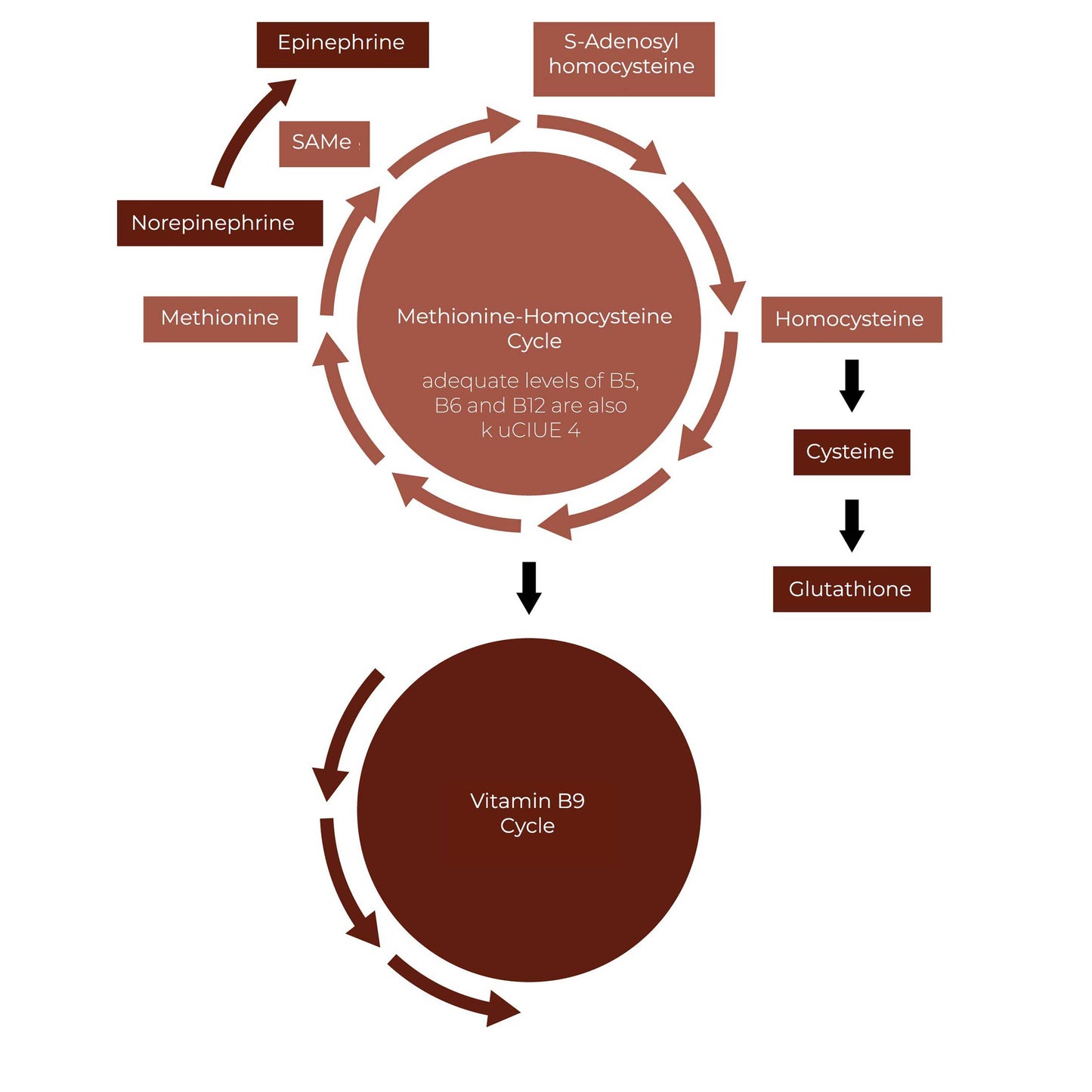
Overview
All B vitamins contribute to healthy brain function, but most research focuses on B5, B6, B9, and B12 – due to their crucial role in homocysteine metabolism. High homocysteine levels and suboptimal B5, B6, B9, and B12 intake are interconnected and modifiable risk factors for brain degeneration, cerebrovascular concerns, mood imbalance, and cognitive decline. Supplemental B5, B6, B9, and B12 have been shown to help balance homocysteine levels in a healthy range associated with strong overall mental performance.
Methylation ensures the vitamins are highly bioavailable and thus more effective.

Other Common Names
Vitamins B5, B6, B9, and B12, Pantothenic acid, Pantothenate, Pyridoxal-5-Phosphate, Pyridoxal Phosphate, P-5-P, P5P, PLP, Folate, Folic Acid, Calcium Folinate, Folinic Acid, 5′-Methyltetrahydrofolate, L-5′-Methyltetrahydrofolate, Methyl THF, L-Methylfolate, Pteroyl-L-Glutamate, Methylcobalamin
Top Benefits
Vitamins B5, B6, B9, and B12 target homocysteine as a synergistic quartet, helping with mental performance concerns related to cognitive decline, brain aging, and low blood flow to the brain. Vitamins B5, B6, B9, and B12 have also been shown to promote mood balance, mental energy, information storage, and long-range brain health.
The benefits seem limited to methylated forms of Vitamins B5, B6, B9, and B12.
Please consider this post for an introductory discussion on methylation.
Support energy metabolism
Support brain function
Supports genetic stability
Supports production and maintenance of new cells
Supports cardiovascular function
Support cellular metabolism
Support methylation
Vitamins B5, B6, B9, and B12 Key Mechanisms
Vitamin B5
Synthesis of coenzyme A (CoA) requires Vitamin B5 [1]
Coenzyme A is a cofactor in several critical cellular metabolic pathways [2]
Coenzyme A has a crucial role in energy metabolism, especially the conversion of sugars and fats into energy [3]
Coenzyme A is needed for the synthesis of the neurotransmitter acetylcholine [4]
Nutrient Synergies
Methyl Donors: essential methyl donor nutrients include trimethylglycine (betaine), vitamin B6, B9, B12, and S-adenosylmethionine.
Vitamin B6
Energy metabolism
Vitamin B6 is a cofactor in a great many essential enzyme reactions, including enzymes of fatty acid, glucose, and amino acid metabolism [5]
Vitamin B6 is a cofactor in the kynurenine pathway; it is needed for the synthesis of NAD+ from tryptophan [6]
Hemoglobin synthesis
Vitamin B6 is required as a cofactor in the synthesis of heme, an iron-containing molecule found in hemoglobin [7]
Neurotransmitter function
Vitamin is required for the activity of the enzyme aromatic L-amino acid decarboxylase, which catalyzes the synthesis of serotonin from 5-hydroxytryptophan (5-HTP) and dopamine from L-3,4-dihydroxyphenylalanine (L-DOPA) [8, 9]
Vitamin B6 is required for dopamine synthesis since dopamine is a precursor for noradrenaline [8]
Since serotonin is a precursor for melatonin, P5P is required for its synthesis [9]
Vitamin B6 is required for the activity of the enzyme glutamate decarboxylase, which catalyzes the synthesis of gamma-aminobutyric acid (GABA) from glutamate [10]
P5P also plays a vital role in the metabolism of several neurotransmitters like glycine, D-serine, and histamine [11]
Supports memory formation, executive function, mood regulation, sleep regulation, focus, and motivation [12, 13]
Cardiovascular and cerebrovascular function
Protects cardiovascular function by downregulating homocysteine levels; synergistic with vitamin B5, B6, and vitamin B12 [10–13]
Nutrient Synergies
Methyl Donors: essential methyl donor nutrients include trimethylglycine (betaine), vitamin B5, B9, B12, and S-adenosylmethionine.
VITAMIN B9
Cellular function
Folate coenzymes conciliate the transfer of one-carbon units (one-carbon metabolism) [14]
Folate coenzymes play a role as cofactors for multiples enzymes involved in vital metabolic pathways, especially in amino and nucleic acid metabolism [14]
The cytosolic enzyme methionine synthase uses methyltetrahydrofolate to create methionine and tetrahydrofolate from homocysteine [14]
Methionine is needed for the synthesis of S-adenosylmethionine (SAMe), a methyl group donor used in many biological methylation reactions [14]
Methionine is a crucial component of the methylation of nucleic acids (DNA and RNA) and proteins [14]
To maintain NAD+ levels, proper folate status is needed [15, 16]
Cardiovascular and cerebrovascular function
Protects cardiovascular function by downregulating homocysteine levels; synergistic with vitamin B5, B6, and vitamin B12 [17–19]
Nutrient Synergies
Vitamin B12 – The primary safety concern associated with high doses of folic acid supplementation might hide a vitamin B12 insufficiency or deficiency. Vitamin B12 is often administered together with folic acid, primarily when more elevated amounts of folates are given.
Methyl Donors: essential methyl donor nutrients include trimethylglycine (betaine), vitamin B5, B6, B12, and S-adenosylmethionine.
VITAMIN B12
Methionine Synthase Activity
Methylcobalamin acts as a cofactor regulating the activity of the cytosolic enzyme methionine synthase [20]
Methionine synthase exchanges the methyl group from methyltetrahydrofolate to homocysteine to create methionine and tetrahydrofolate [20]
Methionine is needed for the synthesis of S-adenosylmethionine (SAMe), a methyl group donor used in several biological methylation reactions [20]
Methionine synthase is crucial for the methylation of nucleic acids, DNA synthesis, and protein synthesis [20]
Cardiovascular and cerebrovascular function
Protects cardiovascular function by downregulating homocysteine levels; synergistic with vitamin B5, B6, and vitamin B9 [21–23]
Nutrient Synergies
Folates: insufficient methylcobalamin slows the regeneration of tetrahydrofolate and traps folates in a form that is not usable by the human body. It can often be corrected with higher doses of folates but can hide a vitamin B12 deficiency. Thus, vitamin B12 is almost always administered together with folates that are supplemented.
Methyl Donors: essential methyl donor nutrients include trimethylglycine (betaine), vitamin B5, B6, B9, and S-adenosylmethionine.
Vitamin B5 Deep Dive
Vitamin B6 Deep Dive
Vitamin B9 Deep Dive
Vitamin B12 Deep Dive
References
- Tahiliani, A. G., & Beinlich, C. J. (1991). Pantothenic acid in health and disease. In Vitamins & Hormones (Vol. 46, pp. 165-228). Academic Press.
- Leonardi, R., Zhang, Y. M., Rock, C. O., & Jackowski, S. (2005). Coenzyme A: back in action. Progress in lipid research, 44(2-3), 125-153.
- Pietrocola, F., Galluzzi, L., Bravo-San Pedro, J. M., Madeo, F., & Kroemer, G. (2015). Acetyl coenzyme A: a central metabolite and second messenger. Cell metabolism, 21(6), 805-821.
- Fisher, S. K., & Wonnacott, S. (2012). Acetylcholine. In Basic neurochemistry (pp. 258-282). Academic Press.
- Works, H. I. 5 Healthy Mood Nutrients To Add To Your Next Meal (Plus A Recipe To Try Them In).
- Badawy, A. A. (2017). Kynurenine pathway of tryptophan metabolism: regulatory and functional aspects. International Journal of Tryptophan Research, 10, 1178646917691938.
- Hunter, G. A., & Ferreira, G. C. (2011). Molecular enzymology of 5-aminolevulinate synthase, the gatekeeper of heme biosynthesis. Biochimica et Biophysica Acta (BBA)-Proteins and Proteomics, 1814(11), 1467-1473.
- Petroff, O. A. (2002). Book review: GABA and glutamate in the human brain. The Neuroscientist, 8(6), 562-573.
- Clayton, P. T. (2006). B 6-responsive disorders: a model of vitamin dependency. Journal of inherited metabolic disease, 29(2-3), 317-326.
- Deijen, J. B., Van der Beek, E. J., Orlebeke, J. F., & Van den Berg, H. (1992). Vitamin B-6 supplementation in older adults: effects on mood, memory, performance and mental effort. Psychopharmacology, 109(4), 489-496.
- Selhub, J. (1999). Homocysteine metabolism. Annual review of nutrition, 19(1), 217-246.
- Heart Outcomes Prevention Evaluation (HOPE) 2 Investigators. “Homocysteine lowering with folic acid and B vitamins in vascular disease.” New England Journal of Medicine 354, no. 15 (2006): 1567-1577.
- Serapinas, D., Boreikaite, E., Bartkeviciute, A., Bandzeviciene, R., Silkunas, M., & Bartkeviciene, D. (2017). The importance of folate, vitamins B6 and B12 for the lowering of homocysteine concentrations for patients with recurrent pregnancy loss and MTHFR mutations. Reproductive Toxicology, 72, 159-163.
- Stanger, O. (2002). Physiology of folic acid in health and disease. Current Drug Metabolism, 3(2), 211-223.
- James, S. J., Yin, L., & Swendseid, M. E. (1989). DNA strand break accumulation, thymidylate synthesis and NAD levels in lymphocytes from methyl donor-deficient rats. The Journal of nutrition, 119(4), 661-664.
- Henning, S. M., Swendseid, M. E., & Coulson, W. F. (1997). Male rats fed methyl-and folate-deficient diets with or without niacin develop hepatic carcinomas associated with decreased tissue NAD concentrations and altered poly (ADP-ribose) polymerase activity. The Journal of nutrition, 127(1), 30-36.
- Selhub, J. (1999). Homocysteine metabolism. Annual review of nutrition, 19(1), 217-246.
- Heart Outcomes Prevention Evaluation (HOPE) 2 Investigators. (2006). Homocysteine lowering with folic acid and B vitamins in vascular disease. New England Journal of Medicine, 354(15), 1567-1577.
- Serapinas, D., Boreikaite, E., Bartkeviciute, A., Bandzeviciene, R., Silkunas, M., & Bartkeviciene, D. (2017). The importance of folate, vitamins B6 and B12 for the lowering of homocysteine concentrations for patients with recurrent pregnancy loss and MTHFR mutations. Reproductive Toxicology, 72, 159-163.
- O’Leary, F., & Samman, S. (2010). Vitamin B12 in health and disease. Nutrients, 2(3), 299-316.
- Selhub, J. (1999). Homocysteine metabolism. Annual review of nutrition, 19(1), 217-246.
- Rabinstein, A. A. (2007). Homocysteine Lowering with Folic Acid and B Vitamins in Vascular Disease Lonn E, for The Heart Outcomes Prevention Evaluation (HOPE) 2 Investigators (McMaster Univ, Hamilton, Ont, Canada; et al) N Engl J Med 354: 1567–1577, 2006. Year Book of Neurology and Neurosurgery, 2007, 12-14.
- Serapinas, D., Boreikaite, E., Bartkeviciute, A., Bandzeviciene, R., Silkunas, M., & Bartkeviciene, D. (2017). The importance of folate, vitamins B6 and B12 for the lowering of homocysteine concentrations for patients with recurrent pregnancy loss and MTHFR mutations. Reproductive Toxicology, 72, 159-163.
